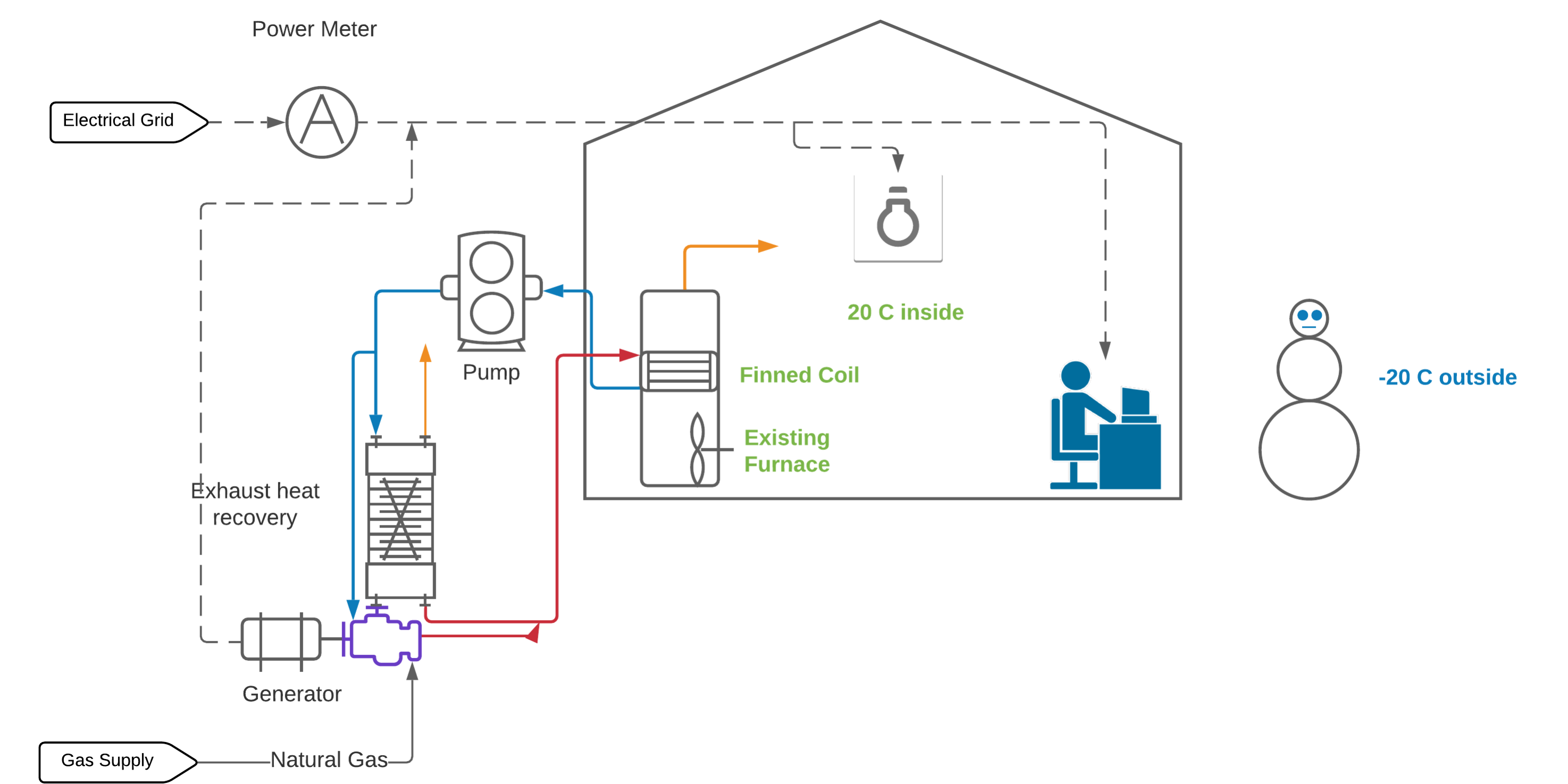Objective
A Combined Heat and Power system (CHP) is an effective way to utilize natural gas. The chemical energy contained in the fuel is used to produce electricity (perhaps with an internal combustion engine), and the waste heat is recovered and used to keep a building at a modest temperature. A previous post demonstrated that, in Alberta, a CHP system could be considered a source of renewable electricity and thus connected to the power grid. One commercial supplier of micro CHP systems is the neoTower series by Yanmar. A system rated for 5 kW of power has an installed cost of approximately $50,000.
The pupose of this article is to determine if this installed cost is expensive when applied to a home in Alberta. We will determine the total installed cost that is needed for residential CHP to be a viable option when compared to a high efficiency furnace.
Overview of residential CHP
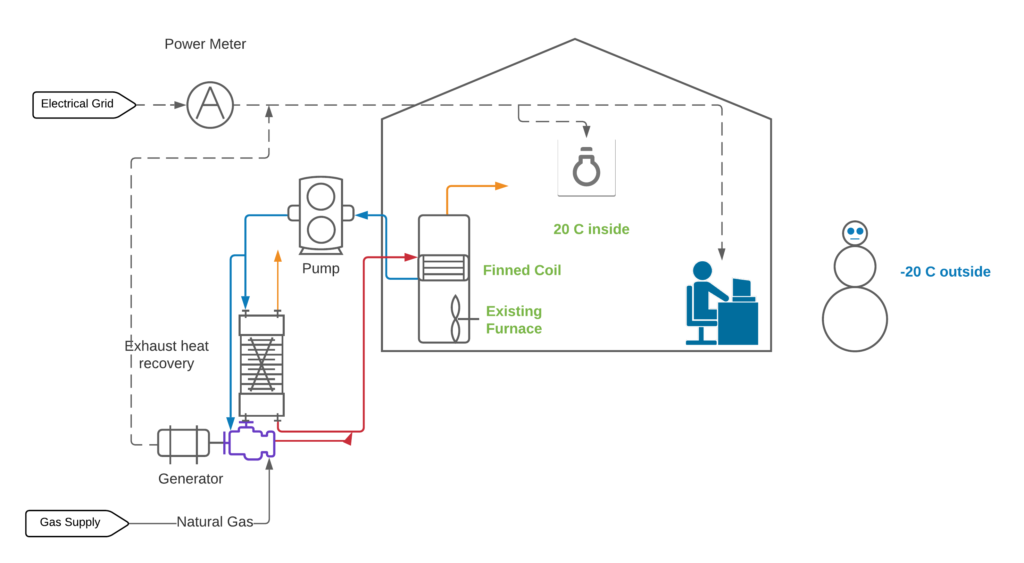
The main features of a CHP are:
- liquid cooled gas engine
- generator
- coolant pump
- exhaust heat recovery
- finned coil in the home
Power generated by the CHP system first supplies the electrical power demanded by the home (reducing demand of power from the grid). Excess power is then sold to the grid. This is called Net Metering. I assume that net metering takes place over each month.
Assumptions
The home in question is mine. I have data for the amount of natural gas that is needed to provide heat, and the amount of electricity that is consumed each month.
I am using the gas and electricity prices from a recent set of utility bills.
- gas purchased at 8.8 $/GJ, based on 3.5 $/GJ gas price.
- electricity purchased at 0.14 $/kW.hr.
- electricity sold to the grid at 0.07 $/kW.hr.
The heating requirements for the house are related to the ambient temperature. I will construct a simple model to predict the heating requirements (in kW) as a function of the ambient temperature. A similar model will be used to relate the electrical demand as a function of ambient temperature.
Ambient temperature data from Environment Canada is used to tabulate the hourly temperature between January 2010 and December 2020. This data are used to calculate the heat requirements at hourly intervals for a ten year duration.
Finally, the cash flow is determined from the value of the electricity produced and the additional fuel consumed (compared to a 100% efficient furnace for providing heat only).
I assume that finances are important. In order for the CHP facility to be attactive, the net revenue from the generated power must pay for the installed equipment in seven years. Since the CHP would be installed instead of an efficient furnace, I will add the installed cost of the furnace (about $5000) to the 5 year payback amount. I will assume that the equipment cost of the CHP is half of the total installed cost.
The Jupyter Notebook and all references are located here
Simple assessment of neoTower
The 5 kW neoTower has an installed cost of approximately $50000$50000. What is the payback period? If we assume that this device produces the rated power for an entire year (100% utilization), the amount of electricity produced is
5.0 kW * 24 hr/day * 365 days = 43,800 kW.hr
At 0.14 $/kW.hr this is worth 6132 $ per year. With a $50,000 installed cost, the payback period is just over 8 years, which is pretty good.
However, this analysis does not consider the amount of heat that can be recovered by the home. The amount of heat that can be recovered determines that amount of electricity that can be produced.
Heating requirement
We will use the data from my utility bill to estimate the heating requirement for my house as a function of ambient temperature. Here are the data for natural gas and electricity demand for a year.
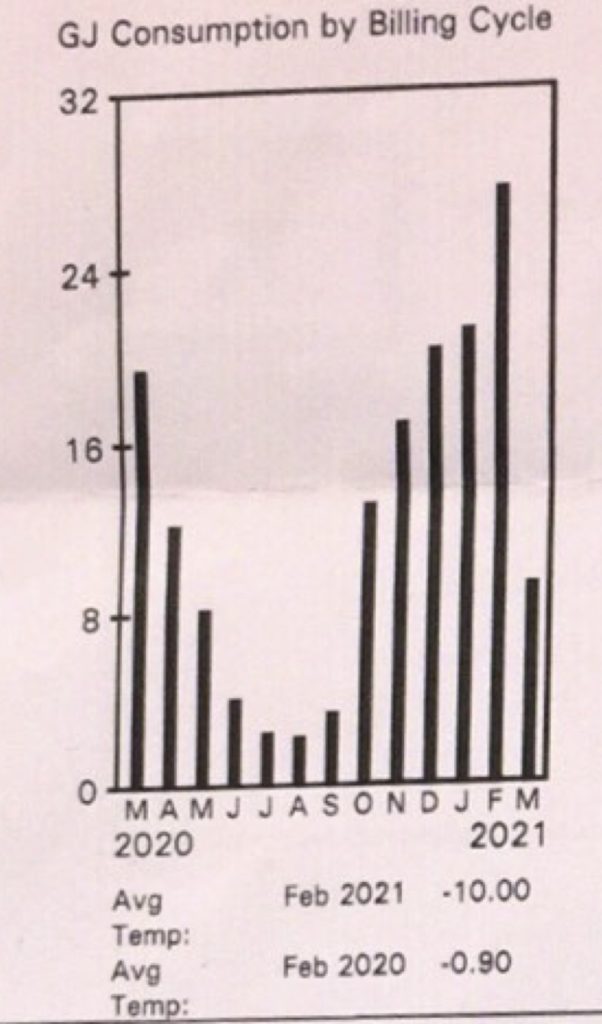
Note that we have a large difference between the amount of heat needed in winter (24 GJ per month) and summer (2 GJ per month).
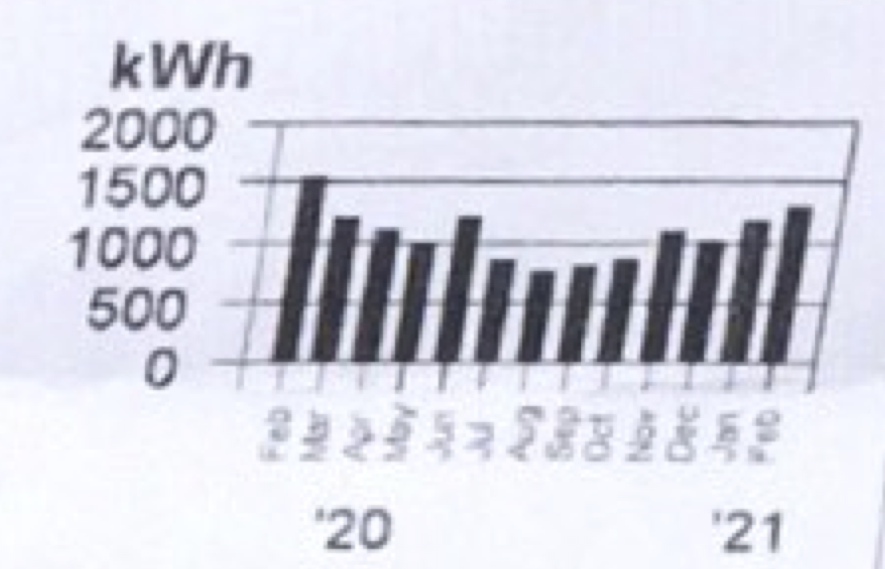
Electrical consumption is a little higher in winter compared to summer.
A parity plot of the gas consumption vs monthly average temperature indicates there is a linear relation, with the exception of the minimum 2 GJ gas supply in the summer months.
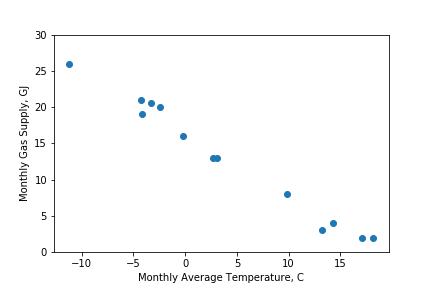
The electrical demand is also related to the ambient temperature.
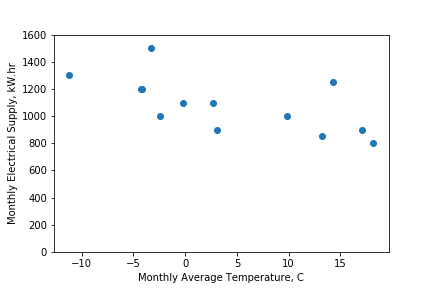
These data were used to create simple models for the heat requirement and electricity requirement for the house as a function of temperature. You will find the model development in the Jupyter Notebook.
Ambient temperature dataset
Lets grab 11 years of data for hourly ambient temperature data for Calgary from Environment Canada. I filled in missing values with the last good value. There are about 100,000 values.
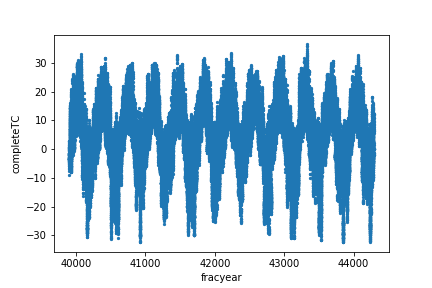
This data shows the annual cycle of high temperatures in the summer and low temperatures in the winter. The daily variation in temperature (highest in the afternoon, lowest at dawn) is too frequent to be discernible. The data shows that there are a few hours in the last 11 years where the ambient temperature touched -30 C. This data will be used to produce a statistical distribution for the ambient temperature for every day in the year.
Let’s look at the temperature distribution. Divide the data in 30 bins.
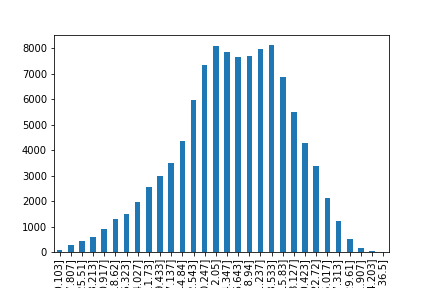
It appears to be bimodal, and I suspect this is evidence of our frequent chinooks.
Heat required by house and electricity generated
For each hourly measured ambient temperature, use the model to calculate the required amount of heat for the home. Estimate for the electrical demand as well. Our correlation will predict a negative value for required heat for the warmest hours in the data set. We will limit the minimum value for heat demand to zero kW.
Assuming 85% overall efficiency and 25% conversion of fuel to electrical power, calculate the amount of natural gas required to drive our CHP unit, and the amount of power produced for each of the 1 hour segments.
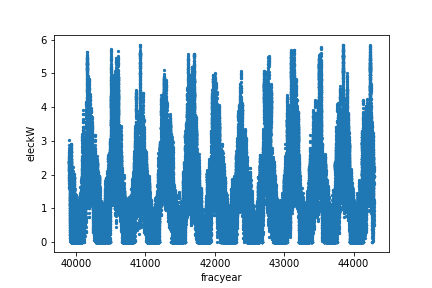
Group the data by each month and calculate the average values for electrical demand, heat demand, fuel supply and electrical supply. The calculated heat demand for the warmest months is pretty close to 1.5 GJ, with seems realistic.
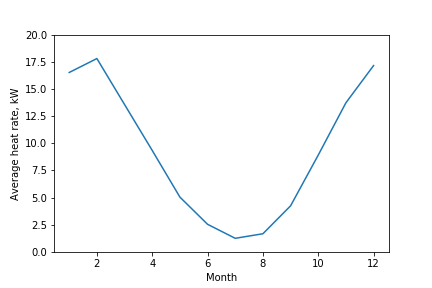
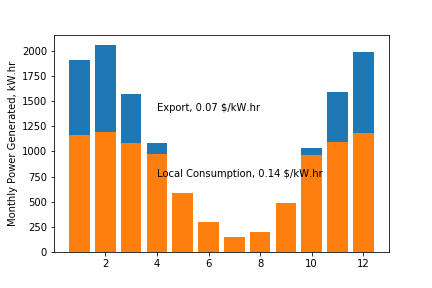
For this home, the CHP system generates almost twice as much heat as needed in the winter. The home would generate 12,938 kW.hr of electricity per year (substantially lower than 43,800 kW.hr needed for 5 kW neoTower to be feasible).The graph above shows the portion of the electricity generated that meets the local consumption (at 0.14 $/kW.hr) and the excess for each month that is sold to the grid at a lower price (0.07 $/kW.hr).
The CHP system is expected to produce $1575 per year in electricity. This requires an additional $655 of natural gas, over and above what would be required for an efficient gas furnace. This produces a cash flow of $920 per year
Economics
Let’s figure out what a reasonable CHP system needs to cost in Alberta. We will consider a 7 year payback period. We will add the $5000 that we would spend on a high efficiency furnace anyways.
920 $/yr * 7 yr + 5000$ = $11,444
We need a total installed cost around $12000 for this residential CHP system to be attractive. This is less than 1/4 of the TIC for the 5 kW Yanmar system.
If the labour cost is about half of the total, then the purchase price must be limited to $6000. Is this purchase price feasible?
A micro CHP system is similar to a medium speed (1800 RPM) liquid cooled gas driven generator. An additional heat exchanger is needed to recover heat from the exhaust, and additional electrical equipment is needed to connect the generator to the grid. Using price data from Home Depot, a 7.5 kW generator (natural gas, air cooled, 3600 RPM) is about $2500. This will generate 3750 W at 1800 RPM. A liquid cooled engine should cost about 80% more, or $4500.
A lower cost system is needed for residential CHP to be feasible in Alberta. As well, an 1800 RPM, liquid cooled industrial natural gas engine may be difficult to find. Most small engines in North America are air cooled gasoline. Small liquid cooled diesel engines are more common in Asia.
I think Alberta could produce a lower cost CHP system. We have experience with small, highly reliable gas engines in the oil & gas industry, and we have a culture of innovation with our farmers. It is time to put these talents to good use.
References
- Approximate TIC for Yanmar 5 kW (January, 2018), https://propane.com/2018/01/16/five-ways-to-tell-if-micro-chp-is-right-for-a-home/.
- Environment Canada Data, https://climate.weather.gc.ca/historical_data/search_historic_data_e.html.
- Replacement cost for a furnace in Calgary, https://jpsfurnace.ca/cost-new-furnace-calgary/

